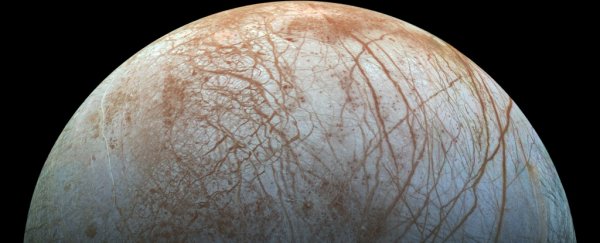Scientists just found even more evidence that Europa - one of Jupiter's 67 known moons - might host alien life deep within its icy oceans. The little moon has long been labelled by NASA as "the most likely place to find life in our Solar System today", thanks to the deep, salty oceans that are strongly suspected to be hidden beneath its frozen crust.
And now a new study has shown that the chemical balance of those oceans would be very similar to the ones here on Earth, suggesting there'd be enough hydrogen and oxygen there for life to form - even without volcanic activity.
"We're studying an alien ocean using methods developed to understand the movement of energy and nutrients in Earth's own systems," said lead researcher Steve Vance, from NASA's Jet Propulsion Laboratory (JPL). "The cycling of oxygen and hydrogen in Europa's ocean will be a major driver for Europa's ocean chemistry and any life there, just as it is on Earth."
To understand how that might work, the team compared Europa's potential for producing hydrogen and oxygen to that of Earth.
For the purposes of this study, they only looked at processes that didn't involve volcanism - volcanic activity is thought of as a kickstart for the formation of life, but the team wanted to see if passive processes on the moon could do the same thing.
And, to their surprise, they calculated that they could. Published in Geophysical Research Letters, the study showed that the amounts of both hydrogen and oxygen would be comparable in scale, and on both worlds, oxygen production is about 10 times higher than hydrogen production.
On Earth, our oceans make hydrogen through something called serpentinisation. That's where salty seawater soaks into cracks in Earth's crust and reacts with the minerals there to produce hydrogen and heat - two important ingredients for life.
The potential for this to happen on Europa was the first thing the researchers focussed on, and based on how the moon has cooled down since its formation, they calculated that it might have fractures in its rocky interior as deep as 25 kilometres (15 miles) - roughly five times deeper than the cracks here on Earth.
In other words, plenty of room for hydrogen to be formed as the ocean water percolates into those cracks.
The team then looked at the potential for oxygen to form. This could happen when the frozen water molecules on the icy surface of the oceans are split apart by cosmic radiation, and the team predicts that these elements would then be cycled back into the depths of the ocean.
So we've got the hydrogen and we've got the oxygen - the missing link now is life. "Whether or not life and biological processes complete the circuit is part of what motivates our exploration of Europa," said one of the researchers, Kevin Hand.
NASA is planning a fly-by mission to Europa in the 2020s, and until we actually send a probe there to scan what's going on under the ice, we can't say for sure whether or not the moon could be suitable for life - or even whether the suspected oceans exist.
There's also a lot more involved in the formation of life than just those two elements - the team now wants to model the cycling of other important elements on Europa, such as carbon, nitrogen, phosphorous, and sulphur.
Either way, this latest research just adds weight to the argument that we need to get out there sooner rather than later to test the waters - literally and figuratively - for ourselves.
We can't wait.
